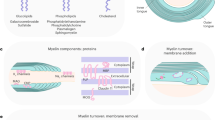Abstract
We have previously shown by X-ray diffraction techniques that the stability of the myelin lattice is decreased by repetitive stimulation of the nerve1. We now show that in rat myelinated fibres this structural change is accompanied by the appearance of voltage-sensitive potassium channels which do not normally participate in the generation of the action potential. Since it has previously been shown that structures associated with potassium channels are found in the internodal and paranodal axolemma membrane but are normally concealed under the myelin sheath2,3, we suggest that the acceleration of myelin swelling after repetitive propagation of the action potential may be due to the opening of paranodal axoglial junctions. To our knowledge this is the first demonstration that nerve activity may regulate the structural properties of the paranode.
This is a preview of subscription content, access via your institution
Access options
Subscribe to this journal
Receive 51 print issues and online access
$199.00 per year
only $3.90 per issue
Buy this article
- Purchase on Springer Link
- Instant access to full article PDF
Prices may be subject to local taxes which are calculated during checkout
Similar content being viewed by others
References
Padrón, R. & Mateu, L. Biophys. J. 39, 183–188 (1982).
Chiu, S. Y. & Ritchie, J. M. Nature 284, 170–171 (1980).
Chiu, S. Y. & Ritchie, J. M. J. Physiol., Lond. 313, 415–437 (1981).
Padrón, R. & Mateu, L. J. Neurosci. Res. 5, 611–620 (1980).
Padrón, R., Mateu, L. & Kirschner, D. A. Biophys. J. 28, 231–239 (1979).
Mateu, L. & Kirchhausen, T. Acta cient. venez. 30, 478–483 (1979).
Padrón, R. & Mateu, L. J. Neurosci. Res. 6, 251–260 (1981).
Sherrat, R. M., Bostock, H. & Sears, T. A. Nature 283, 510–572 (1982).
Ritchie, J. M. J. Physiol., Lond. 317, 25P (1981).
Ritchie, J. M., Rang, H. P. & Pellegrino, R. Nature 294, 257–259 (1982).
Bostock, H., Sears, T. A. & Sherratt, R. M. J. Physiol., Lond. 313, 301–315 (1981).
Horockova, M., Nonner, W. & Stampfli, R. Proc. int. Un. physiol. Sci. 7, 198 (1968).
Bostock, H., Sherrat, R. M. & Sears, T. A. Nature 274, 385–387 (1978).
Brismar, T. J. Physiol., Lond. 298, 171–184 (1979).
Chiu, S. Y., Ritchie, J. M., Rogart, R. & Stagg, D. J. Physiol., Lond. 292, 149–166 (1979).
Blank, W. F. Jr, Bartlett-Bunge, M. & Bunge, R. P. Brain Res. 67, 503–518 (1974).
Baylor, D. A. & Nicholls, J. G. J. Physiol., Lond. 203, 555–569 (1969).
Author information
Authors and Affiliations
Rights and permissions
About this article
Cite this article
Morán, O., Mateu, L. Loosening of paranodal myelin by repetitive propagation of action potentials. Nature 304, 344–345 (1983). https://doi.org/10.1038/304344a0
Received:
Accepted:
Issue Date:
DOI: https://doi.org/10.1038/304344a0
This article is cited by
-
Primary paranode demyelination modulates slowly developing axonal depolarization in a model of axonal injury
Journal of Computational Neuroscience (2014)
-
Structural mobility of living myelinated nerve fibers exposed to proteolytic enzymes
Bulletin of Experimental Biology and Medicine (1989)
-
An X-ray diffraction study of changes in myelin structure during experimental allergic neuritis
Journal of Neurocytology (1987)
Comments
By submitting a comment you agree to abide by our Terms and Community Guidelines. If you find something abusive or that does not comply with our terms or guidelines please flag it as inappropriate.



